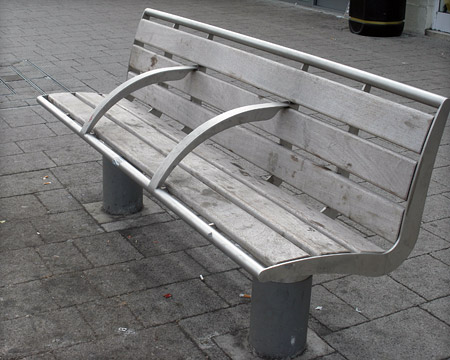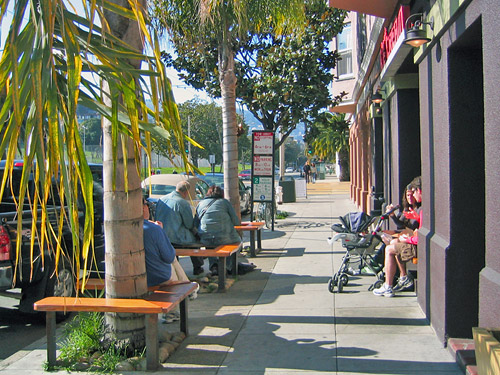See also Street Furniture Overview
Public seating creates a comfortable, useable, and active public environment where people can rest, socialize, read, or people-watch. It is a simple gesture that can go far to create an important sense of place. Seating creates places where people can see and be seen. This ability to entice people to linger is the hallmark of great and successful public spaces.
Adding seating to the public realm is an easy street improvement that can be made by individuals, community groups, business districts, and others, often as part of an overall streetscape project.
Note: This page contains information informal seating along the sidewalk. To learn about permitting seating for outdoor dining, see Outdoor Café and Restaurant Seating.
Process Overview
Benches and seating may be installed by individual property owners, residents, and merchants, or by community groups like neighborhood or merchant’s associations, or as part of a larger package of corridor-wide improvements.
Benches and seating typically require a Minor Sidewalk Encroachment Permit from DPW.
If your project involves multiple streetscape elements, you must obtain relevant permits for all features. For projects involving various streetscape elements, DPW will often streamline the process by combining multiple elements under one or more permits.
Official Codes and Documents
- Better Streets Plan (street design guidelines)
Design Guidelines
Street types: Downtown Commercial, Commercial Throughway, Neighborhood Commercial, Downtown Residential, Residential Throughway, Neighborhood Residential, Industrial, Mixed Use, Parkway, Park Edge, Multi-Way Boulevard, Ceremonial, Alley, Shared Public Way, Paseo
Sidewalk zones: Extension Zone, Furnishing Zone, Frontage Zone
Location of benches and seating
Seating should be located under trees where possible to provide shade and comfort and to integrate multiple elements.
Informal seating (low walls, etc.) may also be incorporated into other elements in the site furnishings zone, such as planter edges. Where space allows, benches can be built into planters.
Where seating is oriented parallel to the curb, it should face toward buildings when located in the furnishings zone, or away from buildings when located in the frontage zone.
Where sidewalk width permits, seating in the furnishing zone should be perpendicular to the curb.
On curb extensions, seating should be organized to create social spaces.
Seating incorporated into building forms, such as seatwalls, may be used as an alternative to free-standing benches.
Seating should be designed to encourage sitting and to discourage lying down.
Given the visual character and amenities in San Francisco and the areas around it, there are many scenic locations where varying from some of these guidelines may be appropriate in order to take full advantage of a street’s setting. For example, seating may be oriented towards a view, rather than towards a street when doing so would provide an additional amenity.
Unfortunately, in some cases fear of loiterers has resulted in seating that is so uncomfortable that no one would want to use it, or the removal of pre-existing seating altogether. The City should maintain a strong presumption against removing seating in the public right-of-way, and should include seating as a standard pedestrian furnishing in new streetscape design projects to encourage usability and activation of the public realm.
Design of benches and seating
Seating and other amenities should be made of durable, high-quality materials. Seating should complement and visually reinforce the design of other streetscape elements.
Seating should be designed as an integrated part of other streetscape elements where possible, including:
- integrated seat walls in pedestrian refuges;
- seat walls and benches around trees and landscaping;
- part of public art and gateway monuments; and
- other elements where integration improves utility of the element to pedestrians without compromising its primary function.
Fifty percent of public benches in a group, or at least 1 bench, must comply with the Americans with Disabilities Act Accessibility Guidelines (ADAAG). See Section 4.32 of ADAAG.
Temporary or moveable seating may also be used, particularly in locations where there is active street management by adjacent businesses, a merchant’s association, or the like. Temporary seating allows people to orient seats to meet specific social and microclimate needs. Moveable seating and tables for sidewalk dining must comply with DPW permit requirements.
See Outdoor Café and Restaurant Seating
Maintenance
With some exceptions, fronting property owners are responsible for the on-going maintenance and upkeep of sidewalk paving as well as all sidewalk elements directly fronting their property, such as trees, landscaping, and streetscape furnishings. Generally, the City is responsible for maintaining roadway paving and other features in the roadway, such as medians.
Typically, if you initiate street or sidewalk improvements, you will be responsible for maintenance of those features. Specific requirements will be described in your permit.
For a more detailed description of maintenance responsibilities, see Maintenance.









 Copyright © 2015
Copyright © 2015